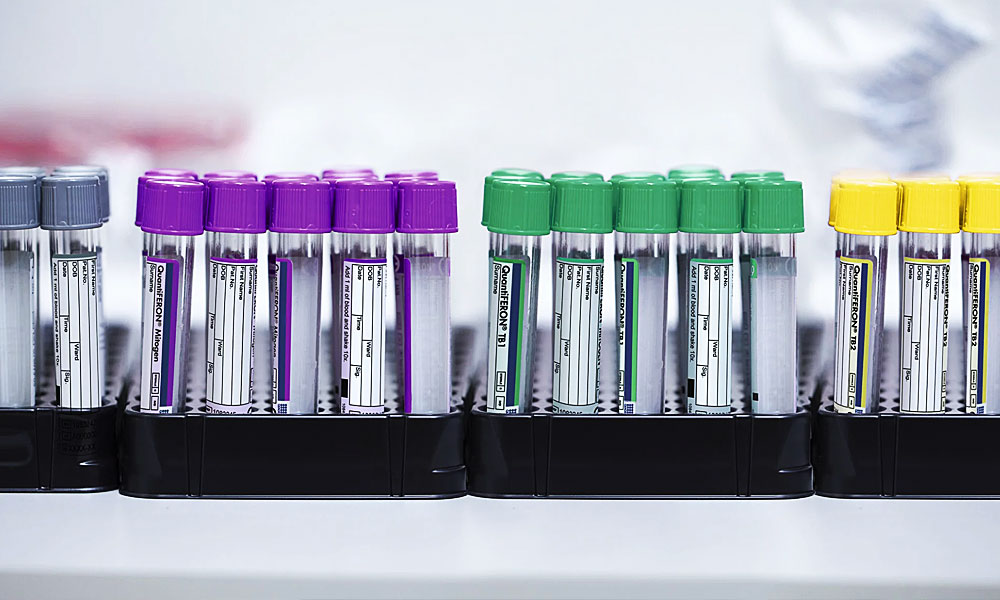Tuberculosis (TB) is a disease caused by Mycobacterium tuberculosis (Mtb). A person infected with MTB might end up with TB disease with clinical, radiographic, and microbiological evidence of tuberculosis, or will have no clinical evidence of TB disease and would be considered latent tuberculosis infection (LTBI); however, about 10% with LTBI will progress or reactivate to active disease.
7,860 cases were reported in 2021 in the United State and it is estimated that up to 13 million Americans are living with Latent TB infection. It is also estimated that one-quarter of the world’s population will be infected with MTB but only 5-10% of them will end up with active TB. Although the favorite place for the bacteria is the lung, it can attack other organs such as kidneys, spine, and brain.
Ending TB will not be effective by treating TB but with increasing effort to identify and treat the latent infection. Early detection of TB infection is crucial to prevent the spread of the disease; there are two types of tests for TB and LTBI: Tuberculin Skin Test (TST) and Interferon-Gamma Release Assay (IGRA).
TST has been used historically to aid in the diagnosis of TB due to the test’s good sensitivity, but false-negative reactions occur more frequently in several groups: infants and young children, after infection, in persons having recently received viral vaccination, in persons with clinical conditions associated with immunosuppression (eg, HIV infection) or overwhelming illness (including extensive or disseminated tuberculosis), after recent viral and bacterial infections, and in association with treatment with immunosuppressive drugs (eg, high-dose corticosteroids, TNF inhibitors). In addition, the specificity of the TST is decreased among persons with prior BCG vaccination, especially those vaccinated post-infancy and those with repeat vaccination. Similarly, persons living in areas where nontuberculous mycobacteria are common are at increased risk of having false-positive TST reactions.
Interferon-Gamma Release Assay (IGRA): QuantiFeron-TB Gold Plus is an IGRA blood-based laboratory test that assesses the cell-mediated immune response to 2 Mycobacterium tuberculosis complex antigens, ESAT-6 and CFP-10, by measuring IFN-gamma levels in plasma. Like the tuberculin skin test (TST), it is an indirect test for M. tuberculosis infection but is more specific than TST because ESAT-6 and CFP-10 are absent from Bacille Calmette-Guerin (BCG) strains and from most non-tuberculosis mycobacteria with the exception of Mycobacterium kansasii, Mycobacterium szulgai, and Mycobacterium marinum.
In an M tuberculosis infection, CD4+ T cells play a critical role in immunological control through secretion of IFN-gamma. Evidence now supports a role for CD8+ T cells in host defense against M tuberculosis infection by likewise producing IFN-gamma, but also by stimulating macrophages to suppress the growth of M tuberculosis, kill infected cells, and directly to lyse intracellular M tuberculosis bacteria. IFN-gamma-producing M tuberculosis-specific CD8+ T cells have been detected in subjects with LTBI and in patients with active TB. ESAT-6 and CFP-10 specific CD8+ T cells have also been more frequently described in patients with active tuberculosis (TB) versus patients with LTBI, and have been detected in HIV-positive patients and children with TB disease. QuantiFERON-TB Gold Plus is the latest version of IGRA tests and is now optimized with innovative tuberculosis-specific antigens that elicit both CD8 and CD4 T cell responses – enabling a more comprehensive assessment of cell-mediated immune response to TB infection.
CDC guidelines provide recommendations for test selection in the diagnosis of M. tuberculosis infection:
- IGRA may be substituted for TST in all situations as an aid in the diagnosis of M. tuberculosis infection
- IGRA is preferred over TST in patients who have received the Bacillus Calmette-Guérin (BCG) vaccination
- IGRA is preferred over TST in patient groups with historically low rates of returning to have TSTs read
- Two-step testing is not required for IGRAs, because IGRA testing does not boost subsequent test result
In addition, the 2016 American Thoracic Society (ATS)/Infectious Disease Society of America (IDSA)/CDC clinical practice guidelines preferentially recommend IGRAs for most US patients ≥5 years of age.
Our clinical diagnostic team believes that increased access to IGRA testing by offering the test in-house greatly benefits the overall health monitoring of geriatric patients who make up much of the nursing home population.
– Dr. Rita Khoury
Have a topic you’d want our Lab Director to cover in future posts? Send suggestions to info@aculabs.com!

